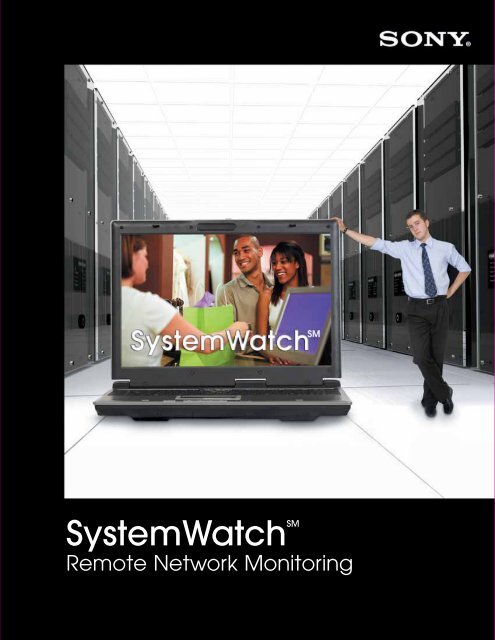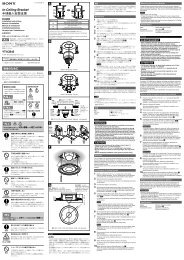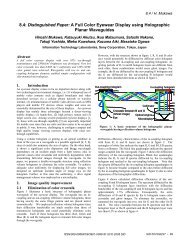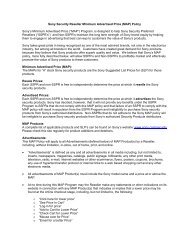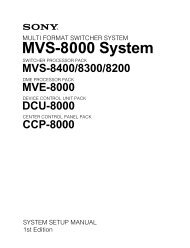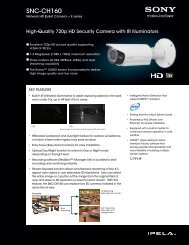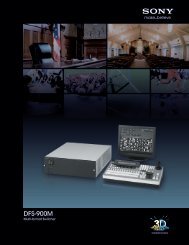SystemWatch - Sony
SystemWatch - Sony
SystemWatch - Sony
Create successful ePaper yourself
Turn your PDF publications into a flip-book with our unique Google optimized e-Paper software.
<strong>SystemWatch</strong><br />
Remote Network Monitoring<br />
SM
<strong>SystemWatch</strong><br />
Network Monitoring Service:<br />
Real World Experience<br />
<strong>Sony</strong>’s <strong>SystemWatch</strong> network monitoring service<br />
uses device and networking monitoring software<br />
in conjunction with 7x24 “live” remote<br />
management of analog and digital device<br />
infrastructure through IP networks. We parse daily,<br />
in real-time, an average of one million pages of<br />
performance logs per site. We do trend analysis of<br />
device and network performance, at predefined<br />
thresholds. Which generates alerts to on-site<br />
engineers to perform pre-emptive actions.<br />
Therefore we seek to prevent rather than react to<br />
operational interruptions. Device restarts can be<br />
initiated from the remote management location<br />
as required.<br />
With more than eight years of real-world<br />
experience, <strong>Sony</strong>’s <strong>SystemWatch</strong> service has<br />
been deployed with a variety of customers, from<br />
broadcast television companies with “live to air”<br />
news systems to retail stores requiring Point of<br />
Sale data transfers to hierarchical storage<br />
environments. Our service has helped them to<br />
operate in a more efficiently and cost-effective<br />
manner, and has assisted customers with system<br />
restarts and recoveries after catastrophic failures<br />
such as power blackouts.<br />
<strong>SystemWatch</strong> Network Monitoring<br />
Service Objectives:<br />
• Maximum up-time for end users utilizing<br />
problem prevention to reduce the possibility<br />
of abnormal occurrence.<br />
• Quick, responsive resolution of any abnormal<br />
occurrence using remote diagnostic<br />
techniques, self-help, operations help, and<br />
visible escalation.<br />
• Minimizing cost for this service to the end user.<br />
• Easy to install, operate and maintain.<br />
• Active communication with the end user.<br />
• Partnership and mutual dependency in<br />
customer satisfaction.<br />
• Measurable feedback to evaluate the<br />
performance.<br />
• Motivated and satisfied technical staff.
<strong>SystemWatch</strong><br />
Network<br />
Monitoring<br />
<strong>Sony</strong>’s <strong>SystemWatch</strong> SM network monitoring is the<br />
highest level of remote monitoring service<br />
offered by <strong>Sony</strong> Professional Services to<br />
customers with 24/7 mission critical business<br />
ecosystems that will be adversely affected<br />
by operational interruptions. Our service<br />
continuously monitors the health of the entire<br />
ecosystem including mission critical systems, the<br />
health of the networks over which the data these<br />
systems generate flow and environmental<br />
conditions affecting system performance.<br />
Using high-speed data networks to link remote<br />
AVIT systems has long been considered<br />
an “ideal” goal. That goal is rapidly becoming<br />
achievable through the combination of<br />
economic driving factors, emerging technologies<br />
and new equipment introductions. However,<br />
maintaining system performance and reliability<br />
requires new approaches to tools and skill sets for<br />
a centralized technical staff using a Network<br />
Monitoring System (NMS). <strong>Sony</strong> Professional<br />
Services addresses some specific issues and<br />
solutions in creating a NMS in an environment of<br />
new and legacy equipment using a managed<br />
object approach.<br />
When moving video and control systems over<br />
IP networks, user visibility of overall system<br />
performance is masked. Content creation<br />
device outputs generated in ISR, SNMP, TCP/IP,<br />
“LIVE” REMOTE<br />
MONITORING<br />
24/7<br />
UDP and other protocols provide performance<br />
metrics at the device level to stand-alone remote<br />
monitoring software applications, but these<br />
applications do not indicate overall network<br />
system health, pre-emptive failure intervention<br />
and performance trending.
<strong>SystemWatch</strong><br />
Network Monitoring Service:<br />
A Closer Look<br />
<strong>Sony</strong>’s <strong>SystemWatch</strong> network monitoring is a<br />
service that provides 24 hour, seven days a week,<br />
remote network monitoring of CPU and memory<br />
utilization, hard disk drives, network load, and<br />
other event monitor parameters. Computer<br />
resource monitoring includes the overall<br />
percentage of CPU usage, overall memory<br />
availability in megabytes/virtual memory and the<br />
amount of free disk space availability measured<br />
in megabytes. In addition, computer systems and<br />
device resource usage is monitored and<br />
reported upon.<br />
A Typical System Diagram<br />
Windows ® NT<br />
Computers With<br />
MRTG<br />
Installed<br />
NT<br />
Workstation<br />
NewsBase Systems<br />
Performance Reports<br />
Event reports<br />
NT<br />
Server<br />
Internet / VPN<br />
MRTG Events SNMP Events<br />
Unix ®<br />
Workstation<br />
Network traffic is monitored by measuring the<br />
throughput for each host in bytes and packets<br />
per second. These elements also assist in<br />
reporting the total network traffic volume.<br />
Process-service monitoring includes service run<br />
changes and process resource utilization. This<br />
assists in determining the percentage of<br />
processor time used by a process, the CPU spike<br />
activity, overall memory used by a process, and<br />
the virtual memory usage.<br />
Local <strong>SystemWatch</strong> Console<br />
Network Node Manager<br />
MRTG Console<br />
Performance Database<br />
Event Database<br />
Local Area Network<br />
Terminal<br />
Server<br />
ISR<br />
Capable<br />
Devices<br />
<strong>SystemWatch</strong><br />
Device Monitor
Internal security is in place with the use of console<br />
security and permissions. <strong>Sony</strong> Professional<br />
Services works closely with customers’ IT<br />
organizations to set and comply with system<br />
access requirements. Consistent with customers’<br />
security requirements, the initialization, installation<br />
and configuration of agents, filters and thresholds<br />
can be automated and updated agents pushed<br />
to system devices.<br />
Hierarchical alerting is based on incremental<br />
thresholds, which includes alerts based on<br />
timed “over-under” thresholds, event-repetition<br />
frequency, specific applications, and multiple<br />
user pathways pre-determined by severity and<br />
repetition.<br />
Utilizing Simple Network Monitoring Protocol<br />
(SNMP), <strong>SystemWatch</strong> network monitoring service<br />
can receive traps based on sender and message<br />
content. SNMP agent polling features MIB values<br />
from devices, results based on message content,<br />
and threshold setting based on polled values. In<br />
addition to monitoring the Windows ® NT 4.0<br />
platform, Windows 2000 Windows Vista operating<br />
systems, <strong>SystemWatch</strong> network monitoring<br />
service is also able to Solaris TM , FreeBSD TM and<br />
Linux TM operating systems.
Daily<br />
Reporting<br />
Historical and trend databases are maintained<br />
allowing for automated graphical performance<br />
reporting, as well as event-trend reporting based<br />
on pre-set filter criteria matching. Reports<br />
including event-alert history, device and<br />
network performance and graphical trend<br />
analysis can be emailed to appropriate<br />
personnel, as well as made accessible on a<br />
secure, password-protected web browser<br />
interface made available to the customers’<br />
designated recipients.<br />
A key factor in understanding system behaviors is<br />
trending performance over time under all<br />
conditions. As usage of the system, network traffic<br />
and demand of resources change, behaviors in<br />
the systems change. The <strong>SystemWatch</strong> service<br />
graphs and trends performance over time. The<br />
result is that systems can be “benchmarked” and<br />
notification thresholds set accordingly. Thresholds<br />
can be adjusted over time. System changes can<br />
also be easily accommodated. Trending<br />
information helps system designers working on<br />
updates and expansions see where bottle necks<br />
may occur.<br />
<strong>SystemWatch</strong> network monitoring staff, located in<br />
<strong>Sony</strong> Professional Services various Network<br />
Operations Centers, interface in real-time with<br />
customers’ personnel when critical or fatal error<br />
conditions are encountered, engaging in remote<br />
diagnostics and problem resolution.
Managed<br />
Objects<br />
Approach<br />
Understanding how systems work together, the<br />
operations performed by them, their behavior,<br />
and contributing external factors such as<br />
environmental conditions are key factors in the<br />
prediction and prevention of operational failure<br />
within the ecosystem. <strong>SystemWatch</strong> network<br />
monitoring service is much more than a simple<br />
software package that attaches to a system<br />
and monitors elements. Rather, it is a powerful<br />
combination of human and machine intelligence<br />
combined in a service that seeks to understand<br />
how systems interact, and assess the impact of<br />
that interaction on the health of the ecosystem.<br />
Each customer’s ecosystem is unique, as is the<br />
service solution <strong>Sony</strong> Professional Services creates<br />
for that customer.<br />
Understanding how systems work together is<br />
achieved using the “Managed Objects”<br />
approach. Managed Objects are defined by<br />
four parameters:<br />
• Attributes, which are the properties or<br />
characteristics of the object.<br />
• Operations, which are performed upon<br />
the object.<br />
• Behavior, which is exhibited in response<br />
to operations.<br />
• Notifications, which are emitted by<br />
the object.<br />
When designing a <strong>SystemWatch</strong> service solution,<br />
<strong>Sony</strong> Professional Services takes the time to<br />
understand how the ecosystem works. It starts<br />
with the “attributes” of the ecosystem and its<br />
components. An attribute is the definition of what a<br />
component is designed to do in order to accomplish<br />
its function.<br />
But, just knowing the functionality is not enough to<br />
keep today’s sophisticated networked systems<br />
operating full time. How the functions are used to<br />
keep the flow of work moving is equally critical.<br />
So, <strong>Sony</strong> Professional Services uses the expertise<br />
of engineers with direct system experience to<br />
understand its operations.<br />
They first gain an understanding of attributes and<br />
work flow, learning the behaviors, or “pulse points” of<br />
the ecosystem’s performance. For example, if a<br />
system has a maximum overhead of 25 memory<br />
pages per second, but typically uses an average of<br />
8 to 9, it is a behavioral aberration if it suddenly starts<br />
to use 15. <strong>SystemWatch</strong> network monitoring service<br />
can trigger a message based on its observation of<br />
aberrant behavior to alert a Network Operations<br />
Center engineer to investigate the cause and work<br />
to prevent a potential operational disruption.<br />
Whether those “pulse points” are SNMP, computer<br />
performance monitors, network traffic, or logged<br />
error messages, <strong>SystemWatch</strong> TM has the capability<br />
to look at the notifications that an object in the<br />
system generates.
©2010 <strong>Sony</strong> Electr onics Inc. All rights reserved. Features and specifications subject to change with out notice. Reproduction in whole or in part without written permission is prohibited.<br />
<strong>Sony</strong> is a trademark of <strong>Sony</strong>. <strong>SystemWatch</strong> is a service ma rk of <strong>Sony</strong>. Unix is a registered trademark of The Open Group. Windows is a registered trademark of Microsoft Corporation.<br />
Solaris is a trademark of Sun Microsystems, Inc. FreeBSD is a registered trademark of The FreeBSD Foundation. Linux is a trademark of Linus Torvalds .<br />
PS-0012-A


